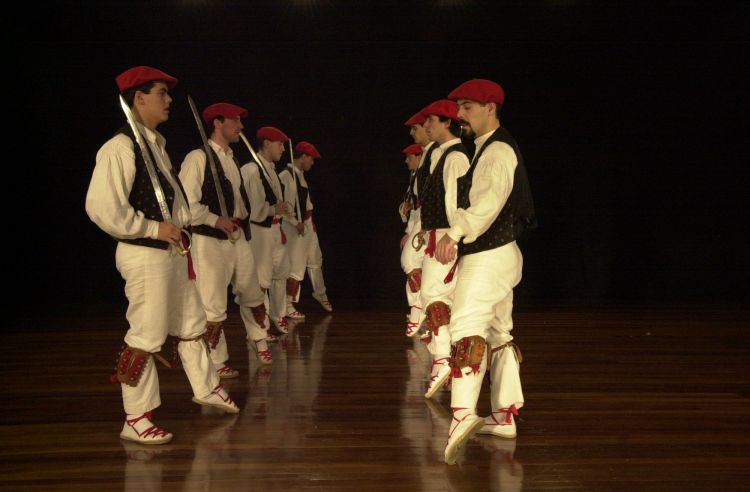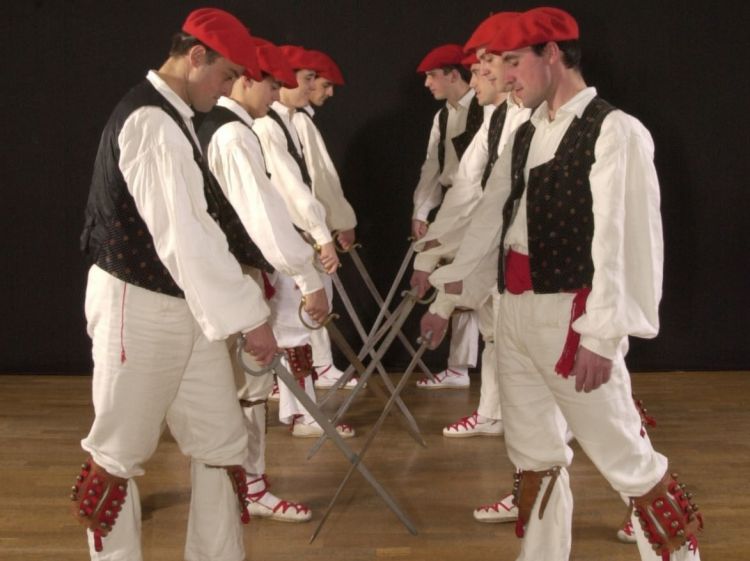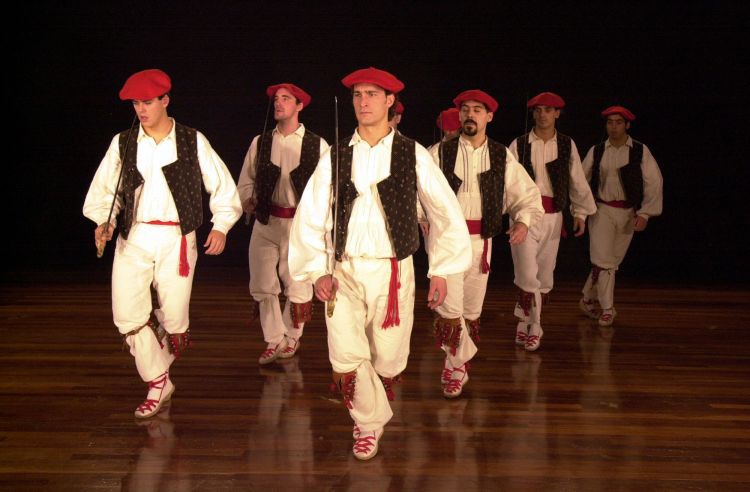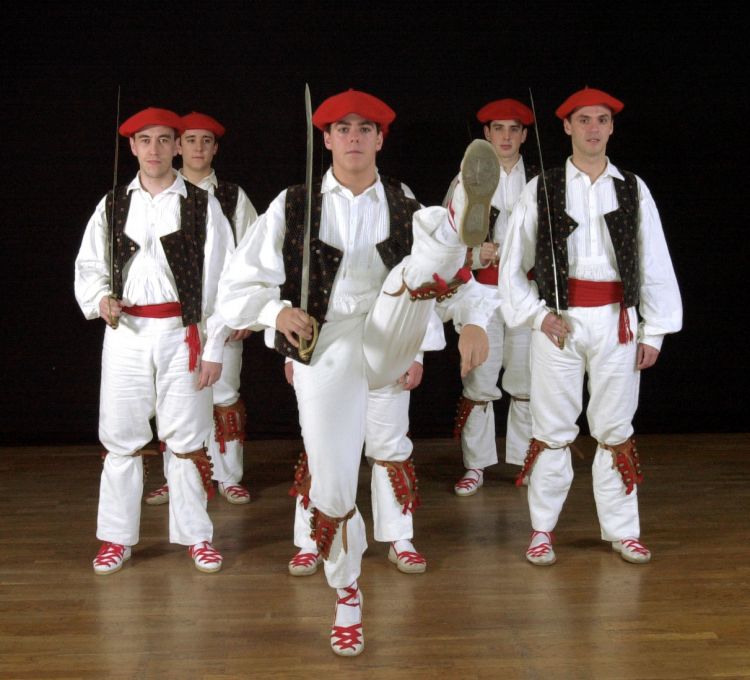Xemeingo Ezpata Dantza
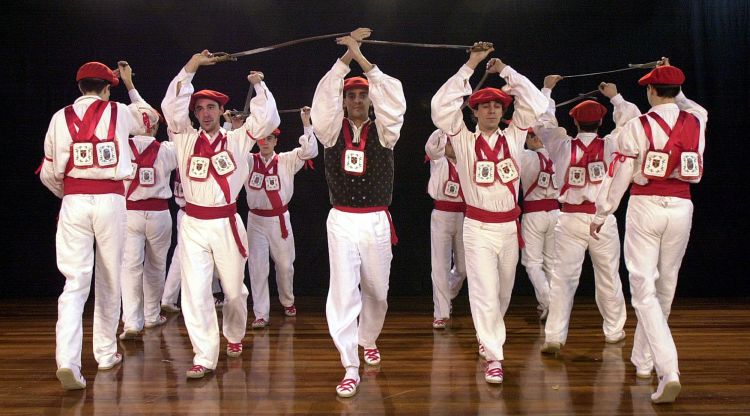
The group of dancers go into the festival enclosure, in this case near the corral to try out oxen situated in front of (opposite) the chapel of San Miguel and the Town Hall, forming two rows joined by the swords. The Maisu Zaharra or Captain leads the way holding the swords of both rows and accompanied by the two Ezpata Txin, bearing daggers. The male dancers go from the Town Hall to the corral to the sound of the txistu and the tabour (timbrel) and the music of the Biribiketa. They go in an anti-clockwise direction, which is interpreted by Curt Sachs as being characteristic of the agricultural, and farming societies with naturalist mythology or centered on the Big Mother Earth, a fact, which appears to coincide with the matriarchism, proposed by several authors.
Once the group of male dancers occupies the centre of the square or the festive enclosure, they form a stack using the union of the swords, and then they move forwards and backwards and finally return to their original position.
The third part of the exhibition is the formation of the rose, that is, a platform of swords made by the group and the Maisu Zaharra is lifted onto it. There are several historic references to similar dances performed in other countries or zones, which mention the intention of attempts to decapitate the so-called Captain. However they are defeated by the skill of the captain and in this sense a few researchers have tried to see in this act the symbolic death of the joker, jester, of the old year, of the spring, of the neophyte, etc.
After raising the Maisu Zaharra above the swords of his companions, and after the offering and acceptance of the daggers, the duel between the two Ezpata Txin begins. It is a fictitious fight (battle) or fencing exercise, which is performed to the front of the group, while at the same time the captain, from on high, performs similar movements with his hands (daggers). This warrior exhibition between two opponents, together with the elevated figure of the captain, appears to be the motive of the mystic interpretation of Segundo de Olaeta who compares the Maisu Zaharra with the Archangel, and the two Ezpata Txin with the forces of Good and Evil, creating their own choreography, but indifferent to the popular feeling which does not seem to recognise a Supreme Good free from Evil.
Eventually the duel finishes (or concludes) without conqueror (victor) or conquered demonstrating the equality peculiar to agricultural societies. The rose breaks up and they return to the beginning. The group returns to the initial position and leaves the square in an anti-clockwise direction. When the exhibition of the sword comes to an end the group of dancers once again occupies the centre to perform the Soka Dantza, the Fandango, the Arin Arin and the Biribilketa with which, traditionally, the festival ends.
Clothing
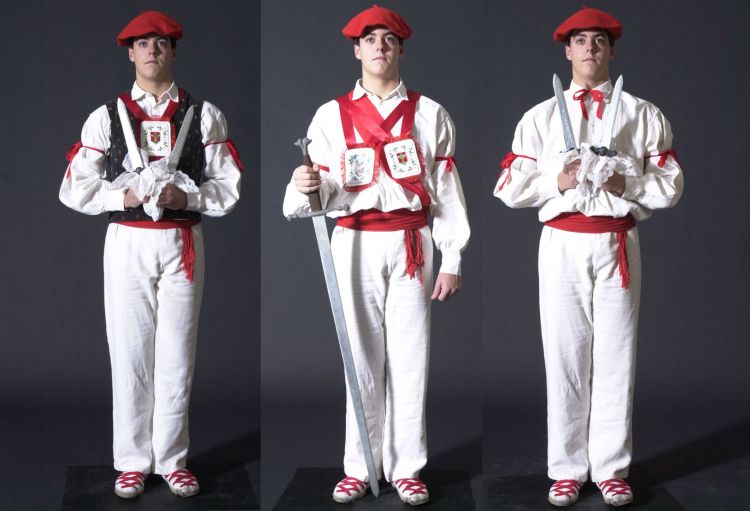
When we begin dealing with the clothes used in the exhibition of the dance of the sword of Xemein we have to take several things into account. Firstly we are talking about a dance with various types of participants. Thus we have to consider:
The Maisu Zaharra or director of the choreography. In the photograph of 1895-96 which illustrates number 37 of the magazine Dantzariak (1987), he appears dressed in white, with ribbons to hold the sleeves, a beret and a corset and a tie which we presume were red, and a sleeveless waistcoat, however in the one of 1915-16, it is simpler, he is not wearing the waistcoat, the ribbons on the sleeves, nor the tie, besides which in the first he appears to be wearing hempen sandals, in the second the dark colour makes us think that he is wearing shoes. We find a further difference when we compare these with the one in number 49 of the same magazine in which we can see tbe maisu zaharra, from the back on the rose, wearing on this occasion a scapulary, and again wearing the waistcoat and the ribbons, this scapulary does not appear in either of the before mentioned photographs, but it does in this one from 1934. His trousers also have a red ribbon all the way down their side seam, the same as the rest of the dancers. In the description that IRIGOYEN and AMUTXASTEGI make (give) in that issue they emphasize that the waistcoat has a pattern of flowers. The Maisu Zaharra is the one who holds the tips of the swords of the first dancers in each row, standing in the middle of these, until he is lifted above the rose, when they offer two daggers with the handles covered with a handkerchief, the same as those of the ezpata txin. There is also mention of a scapulary which is smaller than that of the rest of the group, with the figure of Saint Michael over the chest and shield of Xemein on the back.
The two (or four) guides of the dance: The Ezpata Txin. Normally they mention two dancers who stand to the fore of the group - of those joined by the swords; however, in number 49 of the magazine Dantzariak you can clearly see that in 1934 there were four. Characteristically there are two and in this it differs from the exhibitions in the neighbouring Gipuzkoa, they are at the front of the group and not remaining behind. They wear white shirts and trousers, sandals of the same colour, but the beret, corset, with a bow, the ribbons on the sleeves, the tie, the ribbon or band up the outside seam of the trousers and the ones on the sandals are all red. They do not wear a waistcoat (peculiar to the maisu zaharra) nor scapulary (like the rest of the dancers).
The undefined group of dancers, who intertwine their swords. This is the group of 6 or 8 dancers, at present, although there are references to several dozen (30 in 1734). Their attire is similar to that of the maisu zaharra, with the exception of the waistcoat, exclusive to the captain, and that these wear a red band or ribbon which crosses from their waist to their right shoulder and four scapularies hanging from their necks two at the front with the figure of Saint Michael (on the right) and the shield of Xemein (the one on the left), and another two on their backs, contrariwise to the previous ones. J. L. ETXEBARRIA declares that the scapulary, which the dancers wore, was offered up in the Magdalena on losing their celibacy, which explains why married men did not dance it.
The women who participate in the Soka Dantza, the Fandango and the Arin Arin and finally in the Biribilketa are invited out from the public, so they do not wear any special attire.
Segundo de OLAETA, in the decade of the 40 of the XX century arrives to Markina and Xemein, where the dance of the sword is no longer performed, but there remain sufficient witnesses of its performance to be able to try to restore it. Taking into consideration the information collected orally from previous participants or observers they decided to attempt the exhibition of the choreography after a lapsus of at least two decades. The result, due to the ideological influence of the time, was the creation of a new performance, in which the ezpata txin, the characters who confront each other in a duel without blood with their daggers, identify with the forces of good and evil and the maisu zaharra, he who is lifted above the rose, must represent the general of the celestial milicia. The reason for these changes, rather than a study of the idiosyncrasy of the dances of the country appear to lie in the symbols derived from the figure of the mentioned general, above all in the legendary version which went through the Basque fantasy world, and more specifically possibly coming from the novel of Navarro Villoslada titled Amaya or the Basques in the VIII Century; in this novel a feudal knight named Teodosio, after certain vicissitudes, which we need not explain here, kills his parents, and so must do an extreme penence tied with chains until he receives divine forgiveness. He arrives to the Sierra de Aralar (Nafarroa), where he meets a maid who must be offered in sacrifice to a dragon, as is seen in other legends of the area (Mondragon - Arrasate, etc.). Then the knight appeals to the archangel who comes to his aid and kills the beast. Well, OLAETA must have thought, not without certain logic, that the imaginary Basque man and his rituals should be the same and proposed that one ezpata txin be dressed with the celestial distintives (the band which crosses the chest is blue) and the other with demoniacal (with a red band). The duel turns into a cosmic battle between the forces of good and those of evil which must be defeated, in such a way that the confrontation ends with the death of the evil expata txin, so the maisu zaharra takes part, dressed now as a Roman warrior, with helmet and armour, carrying an ondulated sword (flamigera) and wings due to his celestial condition, and he throws himself, together with the representative of the protective forces, on the Devil.
Thus we find a varying performance of the dance, of recent creation and which has not managed to establish itself with the population (villagers) of the parochial church, who have tried to recuperate, where possible, the old forms (ways).
Implements
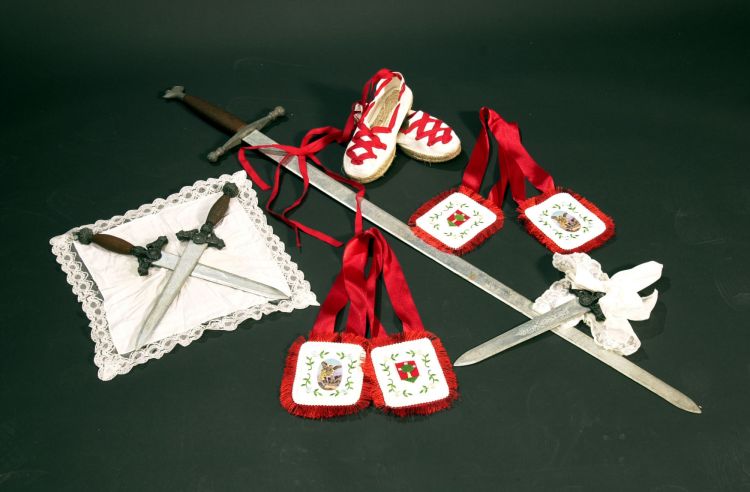
The swords
Unlike the dances of the Duranguesado (Dantzari Dantza) in this case we cannot talk about the sword of knights, too fragil to be able to bear the maisu zaharra. Therefore we are dealing with authentic medieval swords.
It is difficult to establish the length of the swords, because the references to 30 or more dancers imply that these, to be able to form the rose, had to be much longer than normal, which could be changed if there were several groups and not just one. But we cannot confirm it on the basis of empirical facts.
The daggers
Both the two guides of the dance or the expata txin, in the whole exhibition and the maisu zaharra, when he is raised above the rose carry daggers with their handles covered with handkerchiefs with which they perform a series of fencing exercises at eye level and at the back.
The scapularies
These are normally worn by the group of dancers and by the maisu zaharra, on the front they have the shield of the parochial church or the picture of the archangel for protection. The young dancers on losing their celibacy offered these scapularies up.
The handkerchiefs
When performing the Soka Dantza, after the exercises with the sword, the men and women or rather lads and lassies join in this mixed dance.
It appears that the reticences of the church, above all, and of the civil jurisdiction about the problems that could derive from direct contact of the hands of different sexes (exchange of messages, hygiene, holding against the will of some of he participants, etc), decided on the use of handkerchiefs to avoid such embarrassing situations.
Music
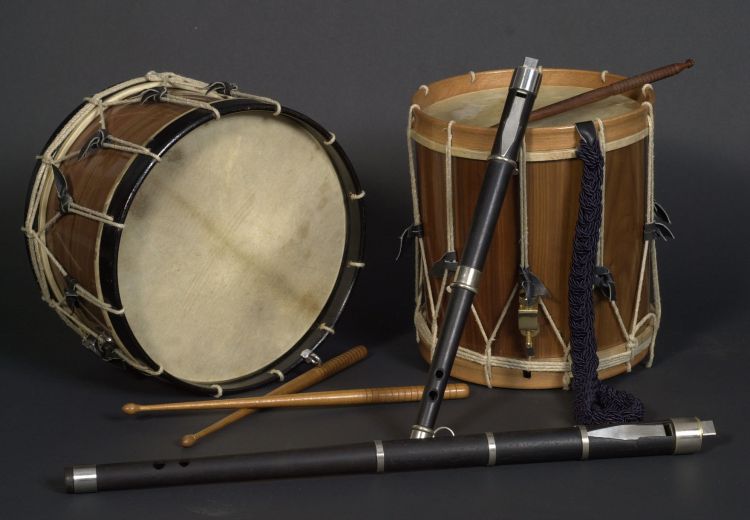
Iñaki IRIGOYEN and Felipe AMUTXASTEGI declare that they did not find any data relating to the musical instruments used in the last three or four centuries apart from the txistu and the tabour. We have already seen above how Curt SACHS mentions the fife, although in the general European area. As the txistu is more popular in our land it would not be surprising if it were this, and not the former, which was used. However we cannot dismiss it, and the authors who we are using as guides also mention its use in the parades of weapons in the XVI century.
History and Geography
The sword dance of Xemein, because of its general structure, belongs to the choreographic class, which spreads beyond the provincial limits of Bizkaia, having elements (aspects) in common firstly with the dances of the neighbouring Gipuzloa, but also with the performances of the rest of the Peninsula and even Europe.
Curt SACHS says the following about the sword dances: "The Dance of the Sword which entered the European folklore as a closed (limited) concept (idea) progressed greatly in the period between the XIV and the XVIII centuries. There is a wide gap in its traditions, in the space of time that goes from then to its origin in ancient Rome. In the XIX century its importance declined and since 1850 it has been conserved as a relic. Once a year or even less frequent, perhaps the Tuesday of Carnival, a group of young bachelors, usually members of a particular trade, gathered together in an open space to practise the dance of the sword; at least six men, but often forty, and in the old Nuremberg over two hundred. Among them there were always two guides and a jester. At times they had their face whitened and generally they dressed in white, with small bells sewn into their clothes and they carried swords in their hands.
The musical instruments most frequently used were the fife and the drum. The dance began with a ceremony of homage; with artificial steps, rotations, figures of eight, chains, rows of snakes, bridges, arches and jumps (leaps) over the sword. After the first part they performed the second, which can be properly named the dance of the battle. The conclusion consisted of the rose, and we must remember that it did not take its name from the flower, as Meschke still believes, but evidently from the rose of the old lauds, from the German term raz, which means plait, the dancers 'plaited' their swords artistically in a figure of a net which was placed on the ground. They danced around it or they lifted it up - at least in the type we have been describing - to carry the guide of the dance as a type of hero or conqueror.
Sometimes they added the 'death' or the resurrection of the jester to the themes. The ceremony came to an end with exhibitions of fencing, a dance and a bow." The description offered by SACHS coincides almost exactly with the exhibition that is made in Xemein; the only difference is the date of the performance, which the author assumes is in Carnival, and now is the days around the equinox of autumn, the 29th September, festivity of Saint Michael. In the area of Bizkaia the dancers do not paint their faces either, however this does occur in other dances in the province peculiar to the Carnestolendas.
The rest of the quotation, however, appears to be a good reflection of the local performances: the use of the txistu, and the tabour (timbrel) as musical instruments, the two guides of the dance, who in this case carry two daggers whose handles are covered with handkerchiefs, the white clothes, the small bells sewn into the clothes and even the condition of being a bachelor which the dancers had to have, as we will see when we refer to the scapularies that they wore. All this coincides completely, the same as the very structure of the exhibition, with the first part being an introduction, the arches or bridges under which the dancers pass, the turning and returning of the same (similar to the dance of arches in Lanestosa), the rose which one of the dancers is lifted up on to, the duel between the two guides, and finally the round of dances (Soka Dantza or Gizon Dantz in our case, accompanied by the Fandango or the Jota and the Arin Arin or Porrusalda, and concluding with the Biribilketa).
Therefore the text mentioned for comparison can be used as a base to situate the performance at least among the dances of the XIV century, if not before that, among those of ancient Rome (we would be dealing with the sacred dances of the brotherhoods of Coribants, Kouretes, Dactilos, Salios, etc.). It is also true that as we are dealing, in our case, with an agricultural and illiterate society we are not likely to find written references of such remote times as ancient Rome, unless it was a travelller who was surprised by the fact and wrote it down which does not seem to be the case. In the same way, even later on in the XIV century, there are no records.
So, although the origin of the exhibition could well go back to those times, it is other more recent times, which are going to offer proof of its ancestry lineage. Without any doubt the authors who have done more research into the historic references of the dance of the sword of Xemein are Iñaki Irigoyen and Felipe AMUTXASTEL, their works, together or separately, have appeared in the magazine Revista Dantzariak, official publication of Euskal Dantzarien Biltzarra, the Basque Dance association. Thus, in issue number 3 (1972) we can find the first references of IRIGOYEN in the article titled Dances in Biscaya and in number 5 (1974) that of Amutxastegi titled Xemeingo Dantza.
However the research really begins to take shape in the numbers (issues) 37 and 49 of the same magazine, where both authors collaborate in the detailed study of the historic facts relating to the dance and other collateral questions. It is going to be mainly these articles, which are going to offer us the first hand information about the history of the dances. Iñaki IRIGOYEN and Felipe AMUTXASTEGI find the first reference to the dances of Xemein, although without specifying yet which dance it is, in 1604, and later on, in 1649, they confirm the existence of a group of dancers who performed dances of sticks, which have disappeared now.
The third reference in chronological and choreographic order, refers to the Soka Dantza or the Aurresku of 1662, a dance that was the motive of ecclesiastical prohibitions with little future. Finally in 1714 they find written evidence of the performance of the dances of the swords and the procession of Saint Michael, payments which have been made up to recently. However it is also noteworthy that in 1743 they mention 30 dancers, a number far superior to the present participants.
Another fact, which we wish to mention, is that a similar dance was performed in the neighbouring parochial church of Exebarria (1756), which broadens our choreographic map. Between the end of the XIX century and the beginning of the XX century its exhibition disappeared completely, and it was not recovered until much later, recreated in its representation and symbolism, returning to its origins in mid XX century.In conclusion we can localise the geographic zone of the dance of the sword of Xemein in said parochial church and the adjacent Etxebarria, linking it also to other zones of the province of Gipuzkoa.
With respect to its history, it is true that the dance of the sword in general goes back to classical Rome and Greece, the most creditable facts, as we are dealing with a written document, mentions it from the XVII century, with previous indications.

